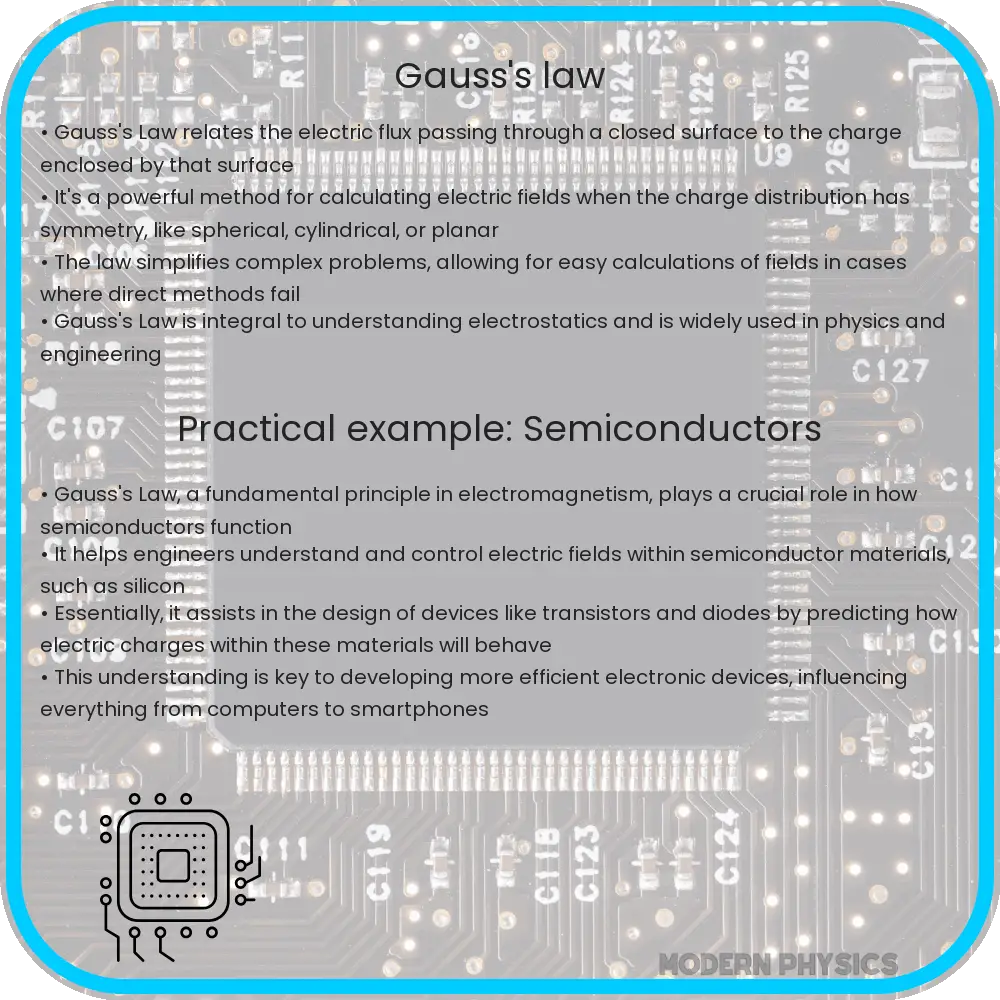Explore Gauss’s Law and its applications in electromagnetism, including electric flux, field calculation, and behaviors in conductors and insulators.

Understanding Gauss’s Law: Charge, Flux, and Electric Fields
Gauss’s Law is a fundamental principle in electromagnetism, encapsulating the relationship between electric charge and electric field. It is one of the four Maxwell’s equations, which form the foundation of classical electromagnetism. Gauss’s Law can be used to calculate the electric field generated by various charge distributions, offering significant insights into how electric fields behave in different scenarios.
Electric Flux and Gaussian Surfaces
At the heart of Gauss’s Law is the concept of electric flux. Electric flux is a measure of the electric field lines passing through a given surface. The choice of surface is crucial and is known as a Gaussian surface. This is an imaginary closed surface used to calculate electric flux and it can be of any shape, as long as it is closed. The total electric flux through the Gaussian surface is proportional to the enclosed electric charge.
Mathematical Formulation of Gauss’s Law
In mathematical terms, Gauss’s Law is expressed as:
\[ \oint \vec{E} \cdot d\vec{A} = \frac{Q_{\text{enc}}}{\varepsilon_{0}} \]
Here, \(\vec{E}\) represents the electric field, \(d\vec{A}\) is a differential area on the Gaussian surface, \(Q_{\text{enc}}\) is the total charge enclosed by the surface, and \(\varepsilon_{0}\) is the permittivity of free space.
Applications of Gauss’s Law
Gauss’s Law is particularly useful in determining the electric field due to symmetric charge distributions such as spherical, cylindrical, and planar distributions. For instance, the electric field outside a uniformly charged sphere can be easily computed using Gauss’s Law, treating the sphere as if all its charge were concentrated at its center.
The law also simplifies calculations in electrostatics, helping in the analysis of electric fields in conductors and insulators. In conductors, the electric field inside is zero when in electrostatic equilibrium, a result that directly follows from Gauss’s Law.
Furthermore, Gauss’s Law aids in understanding more complex concepts in electromagnetism, such as electric displacement and polarization in dielectric materials. This demonstrates the law’s versatility and its critical role in various areas of physics and electrical engineering.
Limitations and Challenges of Gauss’s Law
While Gauss’s Law is incredibly powerful, it has limitations. The law is most effective when applied to systems with high symmetry. In cases of irregular charge distributions, it becomes challenging to use Gauss’s Law to determine the electric field. In such scenarios, other methods like Coulomb’s Law or numerical methods might be more appropriate. Also, Gauss’s Law in its integral form doesn’t provide the direction of the electric field; it only gives its magnitude. To find the direction, one must rely on the symmetry of the charge distribution and an understanding of how electric fields behave.
Electric Fields in Conductors and Insulators
Gauss’s Law is also pivotal in understanding the behavior of electric fields in conductors and insulators. In a conductor, charges redistribute themselves until the electric field inside becomes zero. This redistribution is a direct consequence of Gauss’s Law, which states that the net flux through a closed surface enclosing a conductor is zero when in electrostatic equilibrium. This principle is fundamental in designing electromagnetic shielding and grounding systems.
In insulators, or dielectrics, Gauss’s Law helps explain the phenomenon of polarization, where an external electric field induces a separation of charges, leading to an internal electric field. This concept is crucial in understanding capacitors and their behavior in circuits.
Conclusion
Gauss’s Law is a cornerstone of electromagnetism, providing a profound link between electric charge and electric field. Its simplicity in dealing with symmetric charge distributions makes it an invaluable tool in the physicist’s toolkit. While it faces limitations in asymmetric situations, its applications in understanding electric fields in various contexts — from spherical charge distributions to the behavior of conductors and insulators — underscore its importance. Gauss’s Law not only deepens our understanding of electric fields but also bridges the gap to more complex concepts in electromagnetism, solidifying its role as a fundamental principle in the study of electricity and magnetism.
